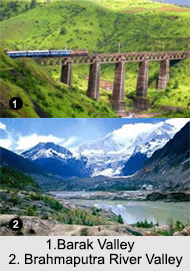 Valleys in Assam are now destinations to the tourists. One who wants to spent a time in the midst of green and waters of the lakes and the rivers, the valleys in Assam are the true ways. Barak Valley and Brahmaputra River Valley are the two most important travel destinations for a nature enthusiast. In addition, these valleys in Assam are the abode of many flora and fauna. White-winged duck or deohanh, Bengal florican, black-breasted parrot bill, red-headed vulture, white-rumped vulture, greater adjutant, Jerdon`s babbler, rufous-necked hornbill, Bengal tiger, Asian elephant, pygmy hog, gaur, wild water buffalo, Indian hog deer, hoolock gibbon, golden langur, capped langur, barasingha, Ganges river dolphin, Barca snakehead, Ganges shark, Burmese python, brahminy river turtle, black pond turtle, Asian forest tortoise, and Assam roofed turtle are the popular members in Assam. The valleys in Assam are remarkably rich in Orchid species and the Foxtail orchid. Kaziranga National Orchid and Biodiversity Park boasts more than 500 of the estimated 1,314 orchid species found in India.
Valleys in Assam are now destinations to the tourists. One who wants to spent a time in the midst of green and waters of the lakes and the rivers, the valleys in Assam are the true ways. Barak Valley and Brahmaputra River Valley are the two most important travel destinations for a nature enthusiast. In addition, these valleys in Assam are the abode of many flora and fauna. White-winged duck or deohanh, Bengal florican, black-breasted parrot bill, red-headed vulture, white-rumped vulture, greater adjutant, Jerdon`s babbler, rufous-necked hornbill, Bengal tiger, Asian elephant, pygmy hog, gaur, wild water buffalo, Indian hog deer, hoolock gibbon, golden langur, capped langur, barasingha, Ganges river dolphin, Barca snakehead, Ganges shark, Burmese python, brahminy river turtle, black pond turtle, Asian forest tortoise, and Assam roofed turtle are the popular members in Assam. The valleys in Assam are remarkably rich in Orchid species and the Foxtail orchid. Kaziranga National Orchid and Biodiversity Park boasts more than 500 of the estimated 1,314 orchid species found in India.
Barak Valley, South Assam
Barak Valley is located in the southern region of the Indian state of Assam. The main city of the valley is Silchar. The region is named after the Barak River. The Barak valley mainly consists of three administrative districts of Assam State - namely Cachar District, Karimganj District, and Hailakandi District. Among these three districts, Cachar and Hailakandi belonged to the erstwhile Cachar district in British India, whereas Karimganj belonged to the Sylhet district of Bangladesh. Karimganj was separated from Sylhet after the Independence of India; with the rest of Sylhet falling under East Pakistan (now Bangladesh) and Karimganj under Independent India.
Brahmaputra Valley
Brahmaputra Valley is a vast region situated between hill ranges of the eastern and northeastern Himalayan Mountain Range. This region in Assam is developed for leisure tourism, nature tourism, eco tourism and rural tourism.
The valley consists of the western Brahmaputra River valley covering the regions of Dhubri, Goalpara and Kamrup; the central Brahmaputra valley region covering Darrang, Nagaon and Sonitpur districts; and, the eastern Brahmaputra valley covering the districts of Lakhimpur, Dibrugarh and Sibsagar. The Teesta River in North Bengal also drains into Brahmaputra River. The Brahmaputra Valley with its rainforest-like climate contains some of the most productive soils in the world. Brahmaputra River flows from Assam to Bengal where it meets the Ganga River to form the world`s largest delta and finally flows into the Bay of Bengal in the south.






